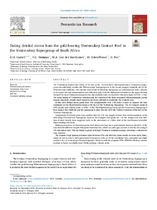Dating detrital zircon from the gold-bearing Ventersdorp contact reef in the Ventersdorp supergroup of South Africa
Abstract
The Ventersdorp Contact Reef (VCR) at the base of the >4.5 km-thick volcanosedimentary Ventersdorp Supergroup unconformably overlies the Witwatersrand Supergroup and is the second youngest mineable reef in the Witwatersrand Goldfields. The volcanic rocks of the Ventersdorp Supergroup are predominantly mafic, affected by low-grade thermal metamorphism and difficult to date. Only the Makwassie Formation in the upper Platberg Group of the main Ventersdorp repository has been reliably dated on four felsic volcanic samples at 2720 ± 2 Ma. The actual timing of Ventersdorp volcanism and the duration of the three recognised lithostratigraphic groups remains enigmatic, despite much research and heroic attempts to synthesize the available data. In this work detrital zircon grains from VCR conglomerates were U-Pb dated in order to improve the time constraints on the Klipriviersberg Group at the base of the Ventersdorp Supergroup. The six youngest grains in VCR samples were reliably dated at 2799 ± 9 Ma. The Klipriviersberg Group and the Ventersdorp Supergroup is thus younger than 2808 Ma and the supergroup is older than the 2642 Ma Vryburg Formation at the base of the Transvaal Supergroup. Comparisons of detrital grain dates confirm that the VCR was largely derived from erosion products of the underlying Witwatersrand Supergroup, however the youngest VCR grains are ~20 Ma younger and may have been derived directly from magmatic rocks in the provenance or a felsic facet of the synchronous komatiitic Klipriviersberg volcanism. Multi-grain analyses of discordant grains show that recent lead loss is predominant.

